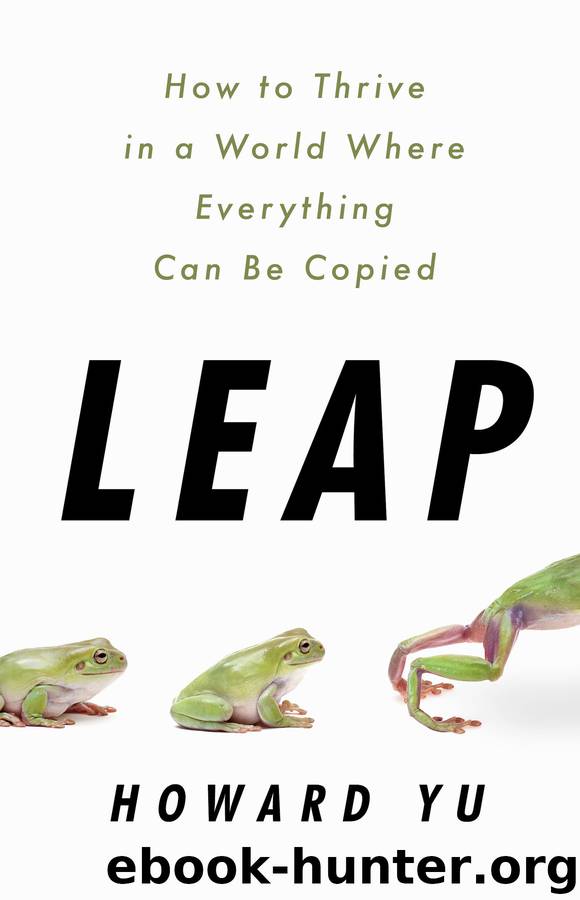Leap by Howard Yu

Author:Howard Yu
Language: eng
Format: epub
Publisher: PublicAffairs
Published: 2018-06-11T16:00:00+00:00
STEPPING OUT FROM THE SHADOW OF THE TECH GIANTS
To Kitamura at Recruit, the company was particularly well positioned at the intersection between offline and online activities. With the successive debuts of various digital platforms, the potential to glean insights from its valuable data became all the more apparent. “Say a customer is seated at a restaurant; such an offline action should trigger information online—[be it] pulling the customer profile to understand her food preference, or tallying up kitchen inventory for the waiter to make spontaneous menu recommendations,” said Kitamura. To Asano, the future is to blend offline and online data to the point where the digital divide vanishes. “If we can grasp that moment of this second wave of digitalization, removing the final boundary between online and offline ahead of Google, Facebook, or even IBM, we can dominate the sphere across all SMEs [small and medium-size enterprises] in Japan, and that will be our winning card.”
The lack of in-house data scientists, however, had hampered Recruit’s progress. That’s the same challenge that Syngenta faced, as we observed in the last chapter. And so, Recruit became the first Japanese company to collaborate with Kaggle—the world’s largest community of about 300,000 data experts—to hold a two-and-a-half–month data prediction competition. In 2015, the company invested in DataRobot Inc., a provider of platforms for general machine learning. These platforms used massive parallel processing to train and analyze thousands of models in open-source languages, including Python, Spark, and H2O. The resolute commitment to data science eventually came in late November, when the board announced an artificial intelligence (AI) research laboratory in Silicon Valley, headed by Dr. Alon Halevy, a heavily cited AI researcher cherry-picked from Google. Like many of his contemporaries, Halevy espoused open software to expedite innovation. Under his watch, all AI development relied on open-source components. He also took a page from Recruit’s existing playbook by co-locating his researchers with existing businesses. Data scientists wouldn’t just write code, but embrace unplanned conversations with customers and sales—an approach that might look odd in Silicon Valley, but a long-established business norm at Japan’s headquarters.
“We have a very interesting collection of datasets, but we don’t have the appropriate tools. What you see at Recruit is that they are excellent at providing services, but they have not really focused on technology in a concentrated way,” Halevy said to me. “It was and still is ‘let us make the service better.’ However, there is now this visceral sentiment that we have to leverage data to make a real difference.” In that regard, Asano couldn’t agree more: “We need Recruit to take high-quality data and turn it into value. We are unique in the sense that we can take a holistic view of our customers.” Being thoroughly pedestrian and small business–oriented, the smiling Kitamura raised his voice in excitement, “We can now see exactly the kind of business opportunity for us to invent new services, in the very sector where we choose to compete.”
Download
This site does not store any files on its server. We only index and link to content provided by other sites. Please contact the content providers to delete copyright contents if any and email us, we'll remove relevant links or contents immediately.
Bad Blood by John Carreyrou(6552)
Rich Dad Poor Dad by Robert T. Kiyosaki(6401)
Principles: Life and Work by Ray Dalio(6209)
Playing to Win_ How Strategy Really Works by A.G. Lafley & Roger L. Martin(5917)
Management Strategies for the Cloud Revolution: How Cloud Computing Is Transforming Business and Why You Can't Afford to Be Left Behind by Charles Babcock(4527)
The Confidence Code by Katty Kay(4187)
Thinking in Bets by Annie Duke(4152)
American Kingpin by Nick Bilton(3756)
Delivering Happiness by Tony Hsieh(3365)
Project Animal Farm: An Accidental Journey into the Secret World of Farming and the Truth About Our Food by Sonia Faruqi(3177)
The Power of Habit by Charles Duhigg(3059)
The Tyranny of Metrics by Jerry Z. Muller(3000)
Brotopia by Emily Chang(3000)
Mastering Bitcoin: Programming the Open Blockchain by Andreas M. Antonopoulos(2981)
The Marketing Plan Handbook: Develop Big-Picture Marketing Plans for Pennies on the Dollar by Robert W. Bly(2975)
I Live in the Future & Here's How It Works by Nick Bilton(2935)
The Content Trap by Bharat Anand(2860)
Building a StoryBrand by Donald Miller(2841)
Applied Empathy by Michael Ventura(2839)
